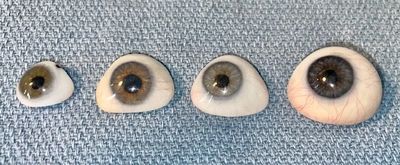Signed in as:
filler@godaddy.com
Signed in as:
filler@godaddy.com
An ocular prosthesis is an artificial eye that is placed within the sockets of patients who have lost their eye due to trauma, cancer, surgical removal, or in patients with congenital absence (anophthalmos) of an eye.
There are two types of eye surgical removal:
Following the enucleation/evisceration, the patient is seen for the fabrication and fitting of the custom ocular prosthesis (artificial eye) in our office. Each ocular prosthesis is as unique as the individual wearing it. We achieve the custom fit by taking a molded impression of your socket with an alginate material similar to what is used in dentistry. This impression mold ensures that every prosthesis will fit flush and comfortably within the socket space. Each prosthesis is then hand-painted, using your fellow eye as a guide for color matching. Jahrling Ocular Prosthetics' goal is to make you look and feel like yourself again.

Ocular prostheses improve volume augmentation, aid in lacrimal and proper lid function, and maintain and stabilize orbital tissue and lid margins. They fill the empty space and allow the socket to retain its proper shape and size. Artificial eyes also support both the upper and lower eyelids to ensure proper facial function. When patients do not wear a prosthesis, many can experience infections, socket changes and other health issues.
It can eliminate physical stress caused by facial imbalance of the eyelids. Artistically, a good matching ocular prosthesis can lessen the psychological hurt of an eye loss.
This is not an unusual question. Of course the answer is no, but we have had patients tell us they can see better when the prosthesis is in the cavity. Our only explanation for this phenomenon is that you have relieved any undue tension on both upper lids when they are symmetrically aligned.
In general, plastic artificial eyes, unlike glass eyes, last for a long time when properly made and cared for. Most ocularists report a replacement is required every 5 to 7 years, because of bony orbit development early in life, and/or tissue changes in adult life. However, we have patients wearing the same prosthesis for over 30 years.
Patients are referred to the ocularist by their eye doctor. Appointments would then be arranged for the following procedures: initial evaluation, impression moulding, prosthetic model fitting, color matching of the iris, sclera and vascular pattern simulation, and fitting of the completed prosthesis.
Yes, you should have routine follow-up visits to determine if your prosthesis needs to be polished and reglazed, or if an adjustment or replacement is required.
Hygiene and Care instructions are listed in our Prosthesis Hygiene & Care section for the plastic ocular prosthesis and the scleral cover shell.
Your meibomian and lacrimal glands, and the mucus membrane release fluid. This combination of liquid causes a protein deposit to gradually accumulate on the prosthetic surface. This build up can irritate the underlying tissue. A daily hygiene routine of cleansing the lids, lashes and surface of the prosthesis (without removal) will forestall the time when it becomes necessary to remove it.
This is dependent upon your ability to completely close the eyelids, if you have any allergies, and your personal hygiene care of the prosthesis. Some patients have to remove it daily, others once a week, a month or annually. We will evaluate your tolerance level after the prosthesis is worn for one month.
Removal and insertion of the prosthesis is relatively simple. Please refer to the instructions located in the Prosthesis Removal & Reinsertion section of our website. During your appointment, we will also instruct you how to remove the prosthesis with a rubber suction cup and also with the fingers. Reinsertion is best done with the fingers.
The top will be identified by a well-defined black dot(s). One black dot for the left eye, and two black dots for the right eye. If someone is assisting you, you can just tell them "dot is top."
This is when you will rely on touch. Each impression molded ocular prosthesis has a unique peripheral contour. In most shapes there will be a noticeable trochlea notch. It is an indentation located on the prosthesis that sets near the upper inner area of the socket. If this is still difficult to identify we will create a nick(s) at the top of the prosthesis. (A technique used for the blind patient).
When an ocular prosthesis is properly fitted, there should be no discomfort. However, on very cold or windy days you may experience dryness on the surface of the prosthesis. This dryness causes the upper eyelid to stick to the prosthesis, especially, if you do blink too often. This may be remedied with a wetting solution.
Any inconvenience would relate more to the loss of sight in one eye, rather than the wearing of a prosthesis. Therefore, the problem is loss of depth perception and a percentage of your peripheral vision. We would refer you to the Frank B. Brady’s book entitled "A Singular View".
Jahrling Ocular Prosthetics, Inc.
1 Garfield Circle, Unit #1, Burlington, MA 01803
MA: 617-523-2280 / RI: 401-454-4168